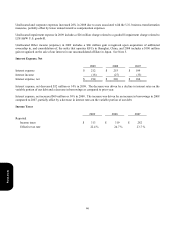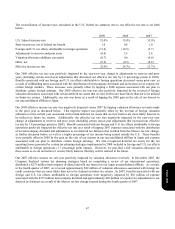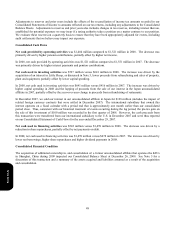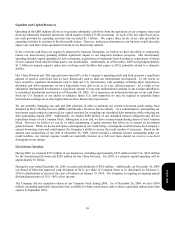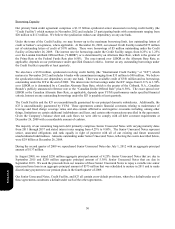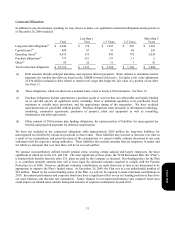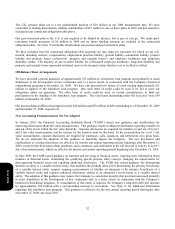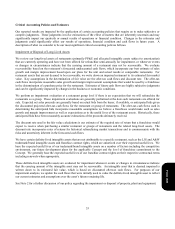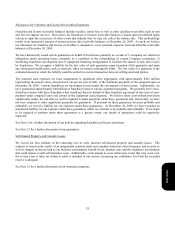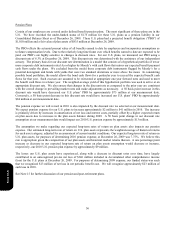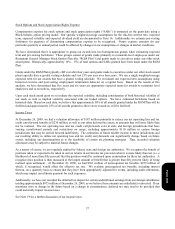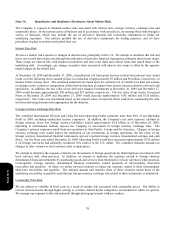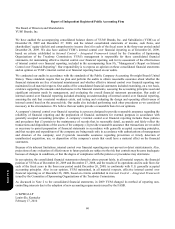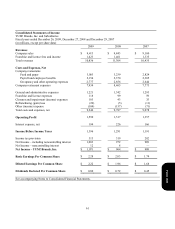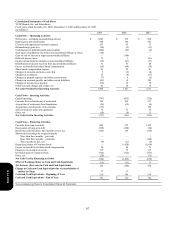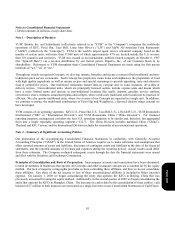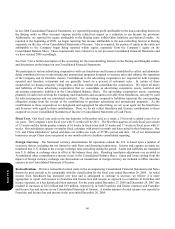Pizza Hut 2009 Annual Report Download - page 147
Download and view the complete annual report
Please find page 147 of the 2009 Pizza Hut annual report below. You can navigate through the pages in the report by either clicking on the pages listed below, or by using the keyword search tool below to find specific information within the annual report.
56
Pension Plans
Certain of our employees are covered under defined benefit pension plans. The most significant of these plans are in the
U.S. We have recorded the under-funded status of $175 million for these U.S. plans as a pension liability in our
Consolidated Balance Sheet as of December 26, 2009. These U.S. plans had a projected benefit obligation (“PBO”) of
$1,010 million and a fair value of plan assets of $835 million at December 26, 2009.
The PBO reflects the actuarial present value of all benefits earned to date by employees and incorporates assumptions as
to future compensation levels. Due to the relatively long time frame over which benefits earned to date are expected to be
paid, our PBO’s are highly sensitive to changes in discount rates. For our U.S. plans, we measured our PBO using a
discount rate of 6.3% at December 26, 2009. This discount rate was determined with the assistance of our independent
actuary. The primary basis for our discount rate determination is a model that consists of a hypothetical portfolio of ten or
more corporate debt instruments rated Aa or higher by Moody’s with cash flows that mirror our expected benefit payment
cash flows under the plans. We excluded from the model those corporate debt instruments flagged by Moody’s for a
potential downgrade and bonds with yields that were two standard deviations or more above the mean. In considering
possible bond portfolios, the model allows the bond cash flows for a particular year to exceed the expected benefit cash
flows for that year. Such excesses are assumed to be reinvested at appropriate one-year forward rates and used to meet
the benefit cash flows in a future year. The weighted-average yield of this hypothetical portfolio was used to arrive at an
appropriate discount rate. We also ensure that changes in the discount rate as compared to the prior year are consistent
with the overall change in prevailing market rates and make adjustments as necessary. A 50 basis point increase in this
discount rate would have decreased our U.S. plans’ PBO by approximately $73 million at our measurement date.
Conversely, a 50 basis point decrease in this discount rate would have increased our U.S. plans’ PBO by approximately
$84 million at our measurement date.
The pension expense we will record in 2010 is also impacted by the discount rate we selected at our measurement date.
We expect pension expense for our U.S. plans to increase approximately $2 million to $41 million in 2010. The increase
is primarily driven by increases in amortization of net loss and interest costs, partially offset by a higher expected return
on plan assets due to increases in the plan assets balance during 2009. A 50 basis point change in our discount rate
assumption at our measurement date would impact our 2010 U.S. pension expense by approximately $13 million.
The assumption we make regarding our expected long-term rates of return on plan assets also impacts our pension
expense. Our estimated long-term rate of return on U.S. plan assets represents the weighted-average of historical returns
for each asset category, adjusted for an assessment of current market conditions. Our expected long-term rate of return on
U.S. plan assets, for purposes of determining 2010 pension expense, at December 26, 2009 was 7.75%. We believe this
rate is appropriate given the composition of our plan assets and historical market returns thereon. A one percentage point
increase or decrease in our expected long-term rate of return on plan assets assumption would decrease or increase,
respectively, our 2010 U.S. pension plan expense by approximately $9 million.
The losses our U.S. plan assets have experienced, along with a decrease in discount rates over time, have largely
contributed to an unrecognized pre-tax net loss of $346 million included in Accumulated other comprehensive income
(loss) for the U.S. plans at December 26, 2009. For purposes of determining 2009 expense, our funded status was such
that we recognized $13 million of net loss in net periodic benefit cost. We will recognize approximately $23 million of
such loss in 2010.
See Note 15 for further discussion of our pension and post-retirement plans.
Form 10-K


